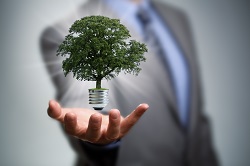Resource efficiency: Powering green growth for Europe
Growing demand and global competition for resources have been putting increasing pressure on the natural environment. Europe needs to stay competitive but it must also lead the way in finding sustainable and environmentally-friendly solutions to address these challenges. To square the circle, the EU has chosen to focus on resource efficiency as a Flagship Initiative under its EU 2020 Strategy for Smart, Sustainable and Inclusive Growth. The EU has also embarked upon a Roadmap to a Resource Efficient Europe that would see Europe’s economy be transformed into a sustainable one by 2050.
Opportunities for all
By shifting to a low-carbon economy powered by green growth and a society that generates and shares economic and environmental benefits for all, European businesses will benefit from new opportunities that will save in material costs and allow them to grow in the face of pressing resource constraints and high environmental standards. This will also serve to maximise resource productivity and minimise resource extraction and waste generation. A vast number of diverse sectors stand to benefit from such a paradigm shift, from waste, industrial production, raw materials and mining, food and agriculture.
EU research leads the way
However, these ambitions will not be realised without cutting-edge research and innovation and this CORDIS Results Pack will showcase eight projects that have been paving the way in transitioning Europe to a more sustainable resource-efficient future. From the food and agricultural sectors, the RESFOOD project has developed an innovative toolkit that will not only ensure the safety and security of our food but will also inject sustainable solutions into the entire food production industry, from reducing the use of water in agricultural and washing processes, to the development of new biosensors to better detect bacteria. The BIOECOSIM project meanwhile has pioneered an efficient method of converting livestock manure into safe and stable organic materials, reducing the environmental impact of fertilisers to achieve real resource efficiencies. EU-funded consortiums are also helping to increase Europe’s cooperation with other countries and regions of the world. The WATER4CROPS project is one such example, a joint collaboration that has harnessed knowledge and experience from Europe and India in developing new water efficiency technologies, targeted at the agricultural sector. Meanwhile, the EWIT project has fostered collaboration between European partners and four African countries (Kenya, South Africa, Zambia and Ivory Coast) to develop an innovative e-Waste toolkit to support better and safer recycling. Finally, empowering businesses and consumers with the tools and processes they need to be more energy efficient is just as vital a building block as new technologies in building a more sufficient, green economy. The GREENECONET project has launched an online platform where SMEs can access tools to help them establish more sustainable business models. The MYECOCOST project has set-up a network that allows companies to calculate the ‘ecoCosts’ of their products or services, for the benefit of both producers and consumers, whilst the RESCOM project has developed a comprehensive framework to assist industries to reuse and remanufacture previously wasted materials, thus contributing to the development of a true Circular Economy. As the EU continues to place emphasis on green growth, resource efficiency and moves towards a circular economy in the coming years, future research projects funded under Horizon 2020 will power forward where these projects have left off. Consequently, this Results Pack will be regularly updated to reflect the newest European innovations for addressing some of the largest economic and environmental challenges to face Europe – and the world – in the twenty-first century.



